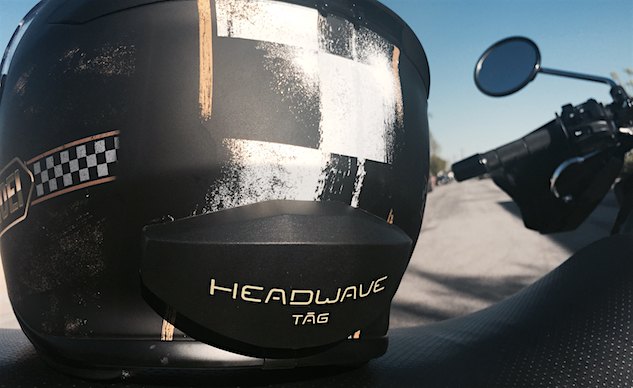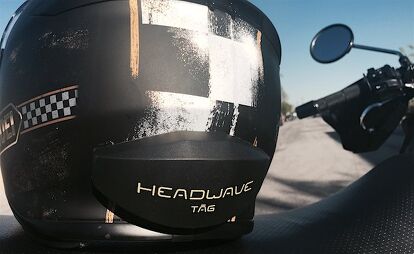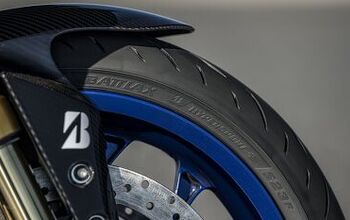MO Tested: Headwave TG
Turning your helmet into a speaker
The idea behind the Headwave TĀG is turning your helmet into a giant, wearable speaker – a “Concert Capsule” as Headwave likes to call it. Does it work? Absolutely. Does it work well? Not really… at least not yet.
According to Headwave, TĀG’s musical magic comes from its ability to harness the vibrational energy from an exciter inside TĀG, then transmit the sound waves through a helmet, producing an immersive sound experience. This is the part that works impressively well. From a standstill to under 55 mph, you’ve your own little concert going on inside your helmet. No speakers uncomfortably pressing against your ears producing tinny music sans bass, TĀG has your whole helmet vibrating with better sounding music coming from everywhere.
MO Tested: Sena 10C Motorcycle Bluetooth Camera & Communication System
Accelerate past 55 mph, though, and you’re SOL. Even with the volume cranked, the sound is drowned out by wind noise, rendering TĀG worthless for even short-distance freeway riding. Behind the windscreen of a Gold Wing, or some other motorcycle with extensive wind protection, the experience may be better, but we can’t say for sure. Herein lies a big problem with TĀG – volume adjustment – as in there is no external way to adjust it.
Once your Bluetooth device is paired to TĀG, you select your music and volume, pocket the device and ride off. Choosing another track or decreasing/increasing volume requires stopping and accessing your device. A pair of BearTek gloves will solve this dilemma. So will having your music player conspicuously mounted, and Nanotips applied to your gloves, or have a pair of gloves that are touchscreen friendly. The other problem with TĀG in regards to volume is its omission of a volume adjuster that automatically increases/decreases volume according to increasing/decreasing wind noise.
TĀG attaches to the bottom rear of your helmet by removing the device’s adhesive backing and pressing firmly. There are no wires to route or speakers to insert. The device measures approximately 5 inches wide by 2.5 inches tall, with a ¾-inch depth. TĀG is neither huge nor small, but, 5.35 ounces, it is fairly heavy. At ⅓ of a pound there’s no not feeling TĀG’s weight. The positioning of TĀG at the rear of your helmet also might interfere with your passenger’s helmet when riding two-up. On the positive side, your passenger can hear the music coming from TĀG almost as well as the rider.
TĀG is constructed of thermoplastic polyurethane. It’s pre-curved and slightly flexible to adapt to the curvature of most helmets. We fitted our TĀG to the back of a Shoei RF1200 with no problem. The high-performance adhesive seemed initially strong enough to keep TĀG attached, but we cannot yet attest for the endurance of the adhesive. We did remove TĀG and reattach it with another adhesive strip, but this one failed to keep TĀG attached. Headwave suggests only removing TĀG if absolutely necessary.
Headwave claims one of TĀG’s best attributes is its simplicity. With a current retail price of $333 (shipping included), but without easy access to volume control, no auto volume adjustment, no ability to use voice commands or even talk on the telephone, TĀG is too one-dimensional to command such a price. Until Headwave can reduce TĀG’s weight, increase its volume and offer more functionality, we’d spend our money on a more traditional communication device.
You can read more about Headwave’s TĀG at the company’s website.
A former Motorcycle.com staffer who has gone on to greener pastures, Tom Roderick still can't get the motorcycle bug out of his system. And honestly, we still miss having him around. Tom is now a regular freelance writer and tester for Motorcycle.com when his schedule allows, and his experience, riding ability, writing talent, and quick wit are still a joy to have – even if we don't get to experience it as much as we used to.
More by Tom Roderick































Comments
Join the conversation
I have sustained significant hearing loss in one ear. I ride with ear plugs all the time to protect what hearing a have left. For a speaker system to have sufficient volume to rise above freeway-levels of wind noise I am wondering what that volume would do to one's ears. I don't recall seeing listings of decibels at a sustained speed for various helmets or speaker combinations with various helmets. Might make for an fun test. I find it interesting to come to a stop in the car, turn down the AC or heater fan and realize how loud the music I've been listening to actually is. Sort of like the frogs in a pot, I wonder if we aren't blissfully unaware that we are slowly destroying our ears.
With my old, inexpensive Sena SMH5 I found that I need to adjust the volume on my Android phone to MAX, then use the knob on the Sena to get the volume right. If I don't I might not be able to get the volume loud enough for some quieter tracks. This is the case with any Bluetooth speakers I hook up to.